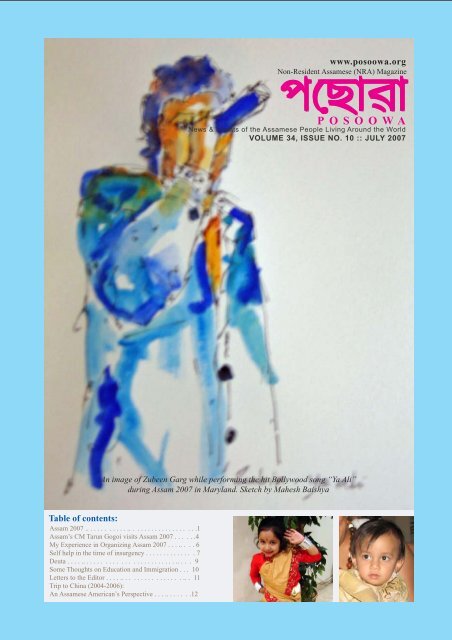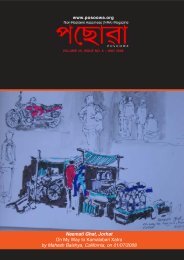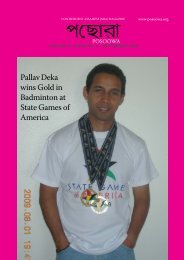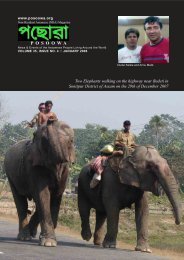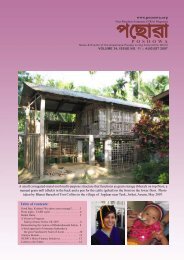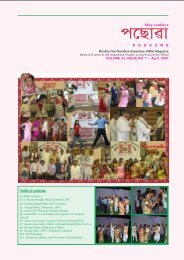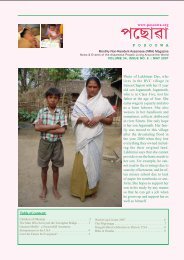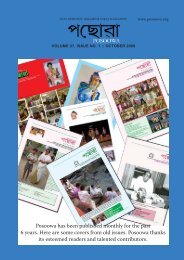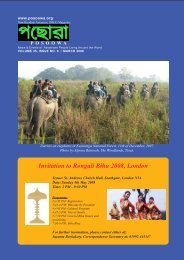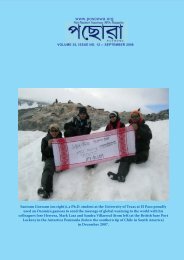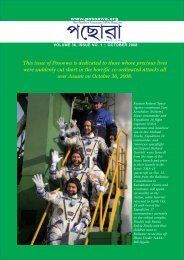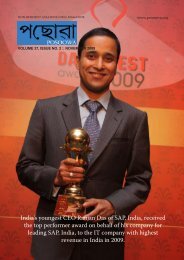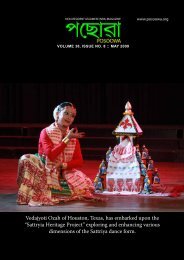July 2007 - Posoowa
July 2007 - Posoowa
July 2007 - Posoowa
Create successful ePaper yourself
Turn your PDF publications into a flip-book with our unique Google optimized e-Paper software.
www.posoowa.org<br />
Non-Resident peCawa<br />
Assamese (NRA) Magazine<br />
POSOOWA<br />
News & Events of the Assamese People Living Around the World<br />
VOLUME 34, ISSUE NO. 10 :: JULY <strong>2007</strong><br />
An image of Zubeen Garg while performing the hit Bollywood song “Ya Ali”<br />
during Assam <strong>2007</strong> in Maryland. Sketch by Mahesh Baishya<br />
Table of contents:<br />
Assam <strong>2007</strong> .. . . . . . . . . . . .. . . . . . . . . . . . . . . . . . .1<br />
Assam’s CM Tarun Gogoi visits Assam <strong>2007</strong> . . . . . .4<br />
My Experience in Organizing Assam <strong>2007</strong> . . . .. . . . 6<br />
Self help in the time of insurgency . . . . . . . . . . . . . . 7<br />
Deuta . . . . .. . . . . . . . . . . . . . . . . . . . . . . . . .. . . . 9<br />
Some Thoughts on Education and Immigration . . . 10<br />
Letters to the Editor . . . . .. . . . . . . . . . . . . . . . .. . 11<br />
Trip to China (2004-2006):<br />
An Assamese American’s Perspective . . . .. . . . . . .12
Assam <strong>2007</strong><br />
Assam <strong>2007</strong>, the eagerly<br />
anticipated yearly Assamese<br />
get-together, was joyously<br />
celebrated recently by people<br />
from all over of North America. This<br />
year’s event was held in the Mid-Atlantic<br />
city of Laurel, MD. Laurel is only 30<br />
minutes from the US capital Washington,<br />
D.C. It is also 30 minutes from the<br />
famous City of Baltimore, Maryland,<br />
where the US fought one of her last battles<br />
with the British Army. Baltimore is also<br />
the place where the lyrics of the Star<br />
Spangled Banner were composed.<br />
Like all previous years, this year also the<br />
event was celebrated during the first<br />
weekend of <strong>July</strong>. It was organized by a<br />
group of very energetic and independent<br />
young individuals from the Northeast part<br />
of the US. This was a gathering where<br />
every Assamese was invited irrespective<br />
of their organizational involvement or<br />
affiliation in the US. Assam Society of<br />
America and ASA Foundation embraced<br />
this celebration and supported the event<br />
organizers. Assam Foundation of North<br />
America participated, raising money for<br />
charitable causes. People came from all<br />
across USA including some visiting guests<br />
and relatives from India. Among the<br />
notable guests, the group had the honor<br />
of hosting the Chief Minister of Assam<br />
along with his beloved wife and an<br />
entourage of delegates from the Indian<br />
Embassy in Washington, D.C. The other<br />
notable guest was the cultural spotlight of<br />
this get-together, Assam’s beloved artist,<br />
very well known in India, Zubeen Garg,<br />
accompanied by his beautiful wife<br />
Garima.<br />
The Organizing Committee for Assam <strong>2007</strong>. Photo by Niranjan Brahma<br />
excellent quality that there were several<br />
thousand hits not only from folks in the<br />
US but also from India. There were many<br />
other hard working folks as members of<br />
various committees. Our heartfelt<br />
gratitude and thanks to each every one of<br />
them. Everyone left Laurel with a very<br />
fun filled positive experience.<br />
The event started in the evening of June<br />
A Bihu Dance during Assam <strong>2007</strong>. Photo by Niranjan Brahma<br />
Assam <strong>2007</strong> was very successful in spirit<br />
and reality! It was due to the relentless<br />
efforts of a hardworking organizing<br />
committee under the leadership of<br />
Niranjan Brahma and Prabin Dutta as the<br />
Chair and Co-chair. Rajib Barua was the<br />
Chair of Souvenir and Website committee,<br />
Sangeeta Dutta led the Chair of Reception<br />
Committee, and Utpal Borah was the<br />
Chair for the Cultural Committee. Ritu<br />
Sharma served as the Chair of the Fund<br />
Raising Committee last but not least<br />
Mukul Chowdhary was the Treasurer.<br />
Without Utpal’s relentless hard work and<br />
perseverance, it would have been<br />
impossible to get a busy and demanding<br />
artist all the way from India to showcase<br />
as the main highlight of the cultural<br />
program. The Website was of such an<br />
A Chorus during Assam <strong>2007</strong>. Photo by Niranjan Brahma<br />
Page 2 * POSOOWA, <strong>July</strong> <strong>2007</strong>
29 th when most of the host committee<br />
members and their families arrived. They<br />
decorated all the rooms reserved for the<br />
events and ended the night with a freestyle<br />
group dance to various songs and<br />
music choreographed on DJ equipments<br />
by our multi-talented artists Marshilla and<br />
Mridu Brahma.<br />
Each of the next two days started with a<br />
healthy breakfast followed by registration<br />
and various events during the day. Each<br />
registrant was given a souvenir bag filled<br />
with goodies: Assam <strong>2007</strong> Gamosha<br />
especially woven and flown in from<br />
Assam, the event Souvenir publication and<br />
a directory of Assamese people not just<br />
only from the US and Canada but also few<br />
other countries.<br />
There were too many activities and<br />
programs to mention them individually<br />
here. Some of the high lights are: the<br />
Trivia questions on Assam, the movie<br />
Jatinga Etyadi, the Assamese Fashion<br />
show where in many instances every<br />
member of a family participated. Many<br />
children participated in programs<br />
performing Bihu dance to Bollywood<br />
dances. We had many talented local<br />
artists. Given the right opportunities,<br />
some of them could be like<br />
Zubeen Garg in time. There<br />
were modern dances, Bihu<br />
dances, Sattriya dances,<br />
classical dances, Husori,<br />
Mukoli Bihu and many other<br />
dances. In the same way there<br />
were many different songs<br />
from Assamese modern, Hindi<br />
filmy ones to Gazals. Of<br />
course, the highlight of the<br />
whole get-together as we<br />
mentioned earlier was muchawaited<br />
performance by<br />
Zubeen that turned out to be<br />
truly electrifying. His songs<br />
were like dance-magnets<br />
Husori during Assam <strong>2007</strong>.<br />
Photo by Niranjan Brahma<br />
when children and adults<br />
alike came forward filling<br />
up the large dance floor,<br />
dancing and bouncing<br />
with his various songs,<br />
including his all too<br />
famous Ya Ali. Zubeen is<br />
already great, but he is<br />
still so young and has so<br />
much potential! The<br />
audience enjoyed the<br />
song so much that he<br />
performed the Ya Ali<br />
twice. He definitely knows how to please<br />
an audience! Many of us believe if he<br />
tries, one day he can be a famous artist<br />
Zubeen Garg at a party. Photo by<br />
Bonmayuri Kalita<br />
A Bihu Dance during Assam <strong>2007</strong>. Sketch<br />
by Mahesh Baishya<br />
Arpita Gogoi and Lola Bora during Assam<br />
<strong>2007</strong>. Photo by Jugal Kalita<br />
even outside India, especially in the US.<br />
He does have the potential.<br />
The food and fellowship were excellent.<br />
People traveled from everywhere not only<br />
for the guest artist or for the cultural<br />
programs, but they also came simply to meet<br />
one another. Where would you get this once<br />
a year opportunity to meet so many Khar<br />
Khua Assamese in one place outside of<br />
Assam?! This group also came together to<br />
raise $1500 dollars for the charitable cause<br />
of supporting Pranjalaya and Parijat<br />
Academy in Axom. In future years,<br />
hopefully we will be able to do more in the<br />
charitable fronts. We thank everyone who<br />
came and joined us in this celebration.<br />
Our best wishes to Zubeen and<br />
many thanks to him for taking the<br />
time off from his busy schedule<br />
to enliven our hearts and our get<br />
together. Everyone also enjoyed<br />
Zubeen and Garima’s down-toearth<br />
personality. We also thank<br />
our guest, the Honorable Chief<br />
Minister, Mr. Tarun Gogoi for<br />
traveling all the way from<br />
Assam. His presence,<br />
presentation and question answer<br />
session really dignified our gettogether.<br />
We wish we could name<br />
everyone who worked to make<br />
Assam <strong>2007</strong> a successful event. There were<br />
simply too many and we also don’t want to<br />
miss any names. So, once again we thank<br />
everyone who worked and participated in<br />
Assam <strong>2007</strong> from the bottom of our hearts.<br />
Hopefully, next year we will be able to do<br />
even better, with more participation and may<br />
be just one joint event for all Assamese<br />
people in the USA rather than get-togethers<br />
in two in different locations on the same<br />
days!<br />
By Dhruba Das<br />
and Niranjan<br />
Brahma<br />
Page 3 * POSOOWA, <strong>July</strong> <strong>2007</strong>
Assam’s CM Tarun Gogoi<br />
visits Assam <strong>2007</strong><br />
T<br />
he Chief Minister<br />
of Assam, Tarun<br />
Gogoi, attended recently<br />
concluded<br />
Assam<strong>2007</strong> in Laurel, Maryland.<br />
This get-together of<br />
non-resident Assamese<br />
(NRA) was an attempt to<br />
bring together the disparate<br />
community together for celebration<br />
of the rich and proud<br />
culture and heritage of Assam<br />
and its people. Assam<strong>2007</strong><br />
started on June 29th and concluded<br />
on <strong>July</strong> 1, <strong>2007</strong>. On<br />
<strong>July</strong> 1st, Assam’s current<br />
CM, Gogoi, arrived the event<br />
site at Ramada Inn in Laurel, Maryland<br />
around 4:15pm. He was accompanied<br />
by his wife Mrs. Dolly Gogoi; H.K.<br />
Sharma, Managing Director of AIDC;<br />
A.K. Sachin, Commissioner of Development<br />
& Planning, Government of<br />
Assam; Bipul Gogoi, Chief Protocol<br />
Officer, CM’s office; and Dr. Naba<br />
Goswami, a well-known physician from<br />
St. Clairesville, Ohio.<br />
The CM and his group were cordially<br />
received by Mukul Chowdhary of<br />
Edison, New Jersey on behalf of<br />
Assam<strong>2007</strong> organizers. This reception<br />
included adorning the CM and his wife<br />
with the traditional<br />
“gamosa” and a “dhol” play<br />
by Utpal Borah of<br />
Glenmoore, Pennsylvania.<br />
Assam<strong>2007</strong> Host Committee<br />
Chair, Niranjan<br />
Brahma, welcomed the CM,<br />
Mrs. Gogoi, and the rest of<br />
the invited guests to a seminar<br />
on the economic and<br />
social development of<br />
Assam. The CM was the<br />
chief guest in this seminar<br />
which was moderated by<br />
Dr. Sanjib Bhuyan of<br />
Franklin Park, New Jersey.<br />
Gogoi thanked the organizers<br />
for inviting him to<br />
Laurel, Maryland, USA, <strong>July</strong> 1, <strong>2007</strong><br />
Chief Minister of Assam Tarun Gogoi, during Assam<br />
<strong>2007</strong>, Photo by Niranjan Brahma<br />
Assam<strong>2007</strong> and congratulated all those<br />
in attendance for celebrating the culture<br />
and heritage of Assam in the U.S.A. In<br />
his brief speech, Gogoi spoke about the<br />
need for involvement of NRAs in Assam<br />
for economic development, particularly<br />
in rural areas. He asserted that government<br />
efforts alone could not solve all the<br />
problems that exist in the State. There<br />
was also need for input from the NRAs<br />
who can provide both monetary and nonmonetary<br />
input and investments in the<br />
State’s various sectors. Gogoi particularly<br />
referred to the energy and industry<br />
sectors which could benefit from nonresident<br />
investment.<br />
Chief Minister of Assam Tarun Gogoi, during Assam <strong>2007</strong>.<br />
Sketch by Mahesh Baishya<br />
Page 4 * POSOOWA, <strong>July</strong> <strong>2007</strong><br />
The seminar had three presentations<br />
which followed the brief talk by the CM.<br />
One of the presentations was by Dr.<br />
Naba Goswami showing an example of<br />
investment by NRAs in Assam – it was<br />
a medical device production facility Dr.<br />
Goswami started in the outskirts of<br />
Guwahati in collaboration with<br />
AIDC, Assam. Such investments<br />
are expected to provide valuable<br />
employment to people in the area<br />
as well as contribute to Assam’s<br />
economy. Dr. Goswami’s presentation<br />
was followed by a presentation<br />
by Dr. Jugal Kalita of<br />
Colorado Springs, Colorado on<br />
the need for expanding engineering<br />
education facilities in Assam,<br />
and how that may lead to both<br />
human development and economic<br />
growth in Assam. The<br />
CM acknowledged that Assam<br />
was far behind when it comes to<br />
education in general and technical<br />
education in particular; he<br />
mentioned steps taken in last few<br />
years, including increasing budget for<br />
higher education, to revamp the education<br />
system in the State in general and<br />
higher education in particular. He informed<br />
the audience that further steps<br />
would be taken to bring the higher education<br />
system in Assam up-to-date.<br />
Partha Gogoi of Fairfax, Virginia was<br />
the last presenter of the evening. Gogoi<br />
showcased various projects taken up by<br />
NRAs in the US through various<br />
Assamese organizations in North<br />
America, such as AFNA and ASA Foundation.<br />
Some of these projects were community<br />
projects, such as<br />
Prajnalaya in Titabor and<br />
Parijat Academy in Pamohi<br />
near Guwahati – both of<br />
which are geared towards<br />
helping children who are less<br />
fortunate. Other projects included<br />
improving the skills<br />
and work potential of<br />
Assamese educated youth<br />
and involved collaboration<br />
with well-known institutions<br />
such as the Assam Institute<br />
of Management located in<br />
Guwahati. Another example<br />
of such involvement by<br />
NRAs in the development of<br />
Assamese manpower included<br />
NEPIF (North East-
ern Professional Institute Forum) – a<br />
forum of 10 management institutes and<br />
engineering colleges from the NE India.<br />
Its objective is to promote training and<br />
placements of graduates of these institutions<br />
by inviting best companies from<br />
outside Assam. Gogoi offered some<br />
strategies regarding how best to receive<br />
help from the NRAs, and that included<br />
helping an image makeover of Assam by<br />
focusing on the positives, by providing<br />
technical skills in the areas of technology,<br />
power, infrastructure, and education,<br />
etc. Gogoi commented that in order<br />
for NRAs to contribute to Assam’s<br />
growth and development, the Government<br />
of Assam needs to make it easier<br />
to work with government agencies, and<br />
encourage government agencies and officials<br />
to support NRA efforts.<br />
A Q&A session moderated by Dr.<br />
Bhuyan followed after the presentations.<br />
Although the audience had the opportunity<br />
to ask questions to all the presenters,<br />
all questions were directed at the<br />
CM. There were many questions directed<br />
at the CM who took all questions<br />
on stride and answered. There were several<br />
questions focusing on the CM’s position<br />
on the chronic flood problem in<br />
Assam and strategies to resolve it.<br />
Gogoi acknowledged the chronic nature<br />
of the problem and pointed out that cooperation<br />
was needed from neighboring<br />
countries and states to find a long-term<br />
solution to the problem, and that his administration<br />
has been working towards<br />
that end. There were questions on the<br />
growing problem of dowry in Assam<br />
which was non-existent in Assam in the<br />
past (the CM assured that he was aware<br />
of the situation and steps were being<br />
taken to revert the problem), how to<br />
make Assam an international doorway<br />
to the SE Asia ( Gogoi mentioned work<br />
in progress and recent visits by SE Asian<br />
dignitaries to assess Assam’s potential<br />
as an international window), dilapidated<br />
transportation and energy infrastructure<br />
and how it was hurting Assam’s economic<br />
development ( Gogoi informed<br />
the audience that there has been significant<br />
improvement in roads and bridges<br />
in Assam since his administration took<br />
office and that he has been working to<br />
improve the energy situation in Assam),<br />
and on his administration plan to deal<br />
with corruption ( Gogoi acknowledged<br />
the existence of corruption but denied<br />
that it was widespread and mentioned<br />
that perception of high corruption has<br />
put Assam next to Bihar as the most corrupt<br />
state in the country. He did not spe-<br />
cifically address how to get rid of corruption.).<br />
After the seminar the audience mingled<br />
with and Mrs. Gogoi and his party before<br />
everyone enjoyed a well-catered<br />
dinner of North Indian cuisine. After<br />
dinner the evening cultural show started<br />
around 8pm. Gogoi and his party left<br />
after enjoying a group “huchori” led by<br />
Mrinal Hazarika of Connecticut. The<br />
festivities continued after the CM left.<br />
Later that evening multitalented singer<br />
from Assam, Zubeen Garg, performed<br />
and thrilled the audience till late into the<br />
early morning hours. Please read the<br />
cultural report by Utpal Borah elsewhere<br />
in this issue of Posowa.<br />
By Sanjib Bhuyan<br />
Please send community news,<br />
event announcements, with<br />
photographs for publication to<br />
posoowa@assam.org .<br />
Please always mention your<br />
contact no., email etc. in case we<br />
need to clarify or may ask for<br />
further information. - Editor<br />
phs for pulication to<br />
Monmi Goswami, daughter of Deep and<br />
Anima Goswami of Fort Collins,<br />
Colorado, graduated from Osgoode Hall<br />
Law School of York University, Toronto,<br />
Canada in June <strong>2007</strong>. She specialized<br />
in Immigration and Human Rights.<br />
Monmi has accepted an Articleship with<br />
Ontario Human Rights Comission in<br />
Toronto.<br />
With compliments of<br />
the Das Family:<br />
Dhruba, Susan<br />
and Elora (standing),<br />
Rupam and Ronju (in<br />
front),<br />
of Coatesville,<br />
Pennsylvania, USA<br />
Dr. Prasanta Kalita was honored by the<br />
University of Illinois for excellence in<br />
teaching and advising. Dr. Kalita, of<br />
Agricultural and Biological Engineering,<br />
was given the life-long title of University<br />
Distinguished Teacher/Scholar in May<br />
<strong>2007</strong>. The award recognizes professors<br />
who display consistently excellent<br />
performance in the classroom, take<br />
innovative approaches to teaching,<br />
positively affect the lives of their students,<br />
and make other contributions to improved<br />
instruction, including influencing the<br />
curriculum.<br />
Page 5 * POSOOWA, <strong>July</strong> <strong>2007</strong>
My Experience in<br />
Organizing Assam <strong>2007</strong><br />
Assam <strong>2007</strong>, a get-together of<br />
Assamese people in North<br />
America, was organized by a<br />
group of people from Maryland,<br />
Delaware, Pennsylvania and New Jersey.<br />
We were called on to take up this special<br />
mission and make the event a memorable<br />
one. I personally was to not ready at the<br />
beginning to take the role of the Chairman<br />
of the Cultural Committee, wondering if<br />
I can fulfill the high expectations of the<br />
vibrant and talented North American<br />
Assamese community.<br />
Deciding on an appropriate guest artist<br />
who is going to enthrall the attendees of<br />
Assam <strong>2007</strong> was the great challenge for<br />
all of us. Some wanted to invite a new<br />
face from Assam and others preferred to<br />
have someone who is already famous.<br />
While discussions were going on, I talked<br />
to Zubeen whom I have known as a friend<br />
for more than 15 years, and he graciously<br />
agreed to attend the Assam <strong>2007</strong><br />
celebrations. Even after we had decided<br />
on Zubeen, there was some confusion and<br />
uncertainty among some of us: will<br />
Zubeen really come and perform in Assam<br />
<strong>2007</strong>? He is famous not only in Assam,<br />
but all over India and around the world<br />
now; will he have the time for the<br />
Assamese community in North America?<br />
From the very beginning, I was a strong<br />
advocate for Zubeen; I was sure that he<br />
will come and will perform in our get-<br />
together without any of his professional<br />
fees.<br />
I followed up with Zubeen and his<br />
manager on a regular basis to keep the pot<br />
boiling. Even though Zubeen had agreed<br />
to come to Assam <strong>2007</strong> without any<br />
charge, still I faced tremendous pressure<br />
to develop a backup plan. I was also asked<br />
by some members of the committee to<br />
have a written confirmation from Zubeen;<br />
I actually got one from him. After the<br />
confirmation was received, the riddle of<br />
sponsorship needed to be solved: who will<br />
sponsor Zubeen so that he will get the visa<br />
without problems? Niranjan Brahma was<br />
a real optimist and he agreed to sponsor<br />
Zubeen. As the Chairman of Assam <strong>2007</strong>,<br />
he wholeheartedly supported me on my<br />
decision to invite Zubeen.<br />
I continued to court Zubeen even more<br />
aggressively as time passed. We bought<br />
electronic tickets and sent them to Zubeen.<br />
Finally on June 30 th Zubeen arrived along<br />
with his wife Garima Garg. And on <strong>July</strong><br />
1 st we all experienced his great show on<br />
the second night of Assam <strong>2007</strong>. Zubeen<br />
rocked! Many of the Assamese individuals<br />
who had come to Assam <strong>2007</strong> had never<br />
danced as they did on <strong>July</strong> 1 st . Many have<br />
told me that they had a wonderful time<br />
and that they had never experienced so<br />
much of fun in last 25 years. I finally feel<br />
vindicated and feel<br />
that I have successfully accomplished my<br />
mission.<br />
The cultural program was held over two<br />
days during the evenings of June 30 th and<br />
<strong>July</strong> 1 st . Whole evening was filled with<br />
attractive songs and dances performed by<br />
invited local artists. We witnessed some<br />
great children’s talent expressed in songs<br />
and dances. We had the opportunity to<br />
listen to Rabin Goswami and Sankumoni<br />
Sarma. Both kept the audience fully<br />
involved and highly entertained. In<br />
addition, the evenings presented great<br />
classical dance performances the were<br />
greatly appreciated, by Bonmyuri Kalita,<br />
Amrita Baruah, Nilaskhi Thakuria,<br />
Sangeeta Dutta and Suravi Kalita. I want<br />
to thank Niraj Borbara for organizing the<br />
Husori. We also thoroughly enjoyed the<br />
great performance of young Assamese<br />
talents such as Rick Bhuyan and Nick<br />
Bhuyan, Mridu Brahma and Marshilla<br />
Brahma. I would like to thank the entire<br />
set of highly talented artists for their great<br />
performance.<br />
The feedback from everyone has been<br />
overwhelmingly positive. I realize that if<br />
we can support each other, we can do even<br />
better in the future; we need to build upon<br />
the trust we have with each other, and we<br />
need to recognize the potential in each<br />
other. It will make our small community<br />
even stronger. I also would like to mention<br />
that I was very happy to see our first<br />
generation Assamese born in this country<br />
in Assam <strong>2007</strong>. I was happy that they fully<br />
participated in the program and enjoyed<br />
it. Our Honorable Chief Minister Mr.<br />
Tarun Gogoi also made the long trip from<br />
Assam to join us for this special occasion.<br />
He even appreciated our Husori and Bihu<br />
performances; I hope we can continue<br />
working on to perform more quality<br />
Husori and Bihu in coming years.<br />
I would like to thank every my cultural<br />
team for his/her support and<br />
understanding. Without their support this<br />
would not have been possible. I would like<br />
to mention that my teammates gave me<br />
enough freedom to work with Zubeen and<br />
gave me the space. My teammates took<br />
care of most of my other responsibilities<br />
so that I can have enough time to follow<br />
up with Zubeen’s needs. This is real good<br />
teamwork. I am<br />
sure we can be<br />
better in future.<br />
By Utpal Borah,<br />
Glenmoore, PA<br />
Sankumoni Sarma and RabinGoswami performed at Assam <strong>2007</strong>. Photo by Jugal Kalita<br />
Page 6 * POSOOWA, <strong>July</strong> <strong>2007</strong>
Self help in the time of<br />
insurgency<br />
Quite often, the state of Asom<br />
garners media headlines for<br />
insurgency related issues.<br />
Surely, the northeastern<br />
state of India is home to<br />
many armed outfits including the United<br />
Liberation Front of Asom, fighting New<br />
Delhi for various demands from self-rule<br />
to sovereignty. But these gun-totting<br />
youth are not the only people in Asom.<br />
The oil and tea rich state has also given<br />
birth to many enterprising men and<br />
women, who are making valiant<br />
endeavors to earn dignified livelihoods.<br />
The poor workforce in rural Asom have<br />
started taking advantage of the few<br />
available Central Government schemes.<br />
Slowly but steadily, some have marked<br />
their points in the profession and have<br />
set example for hundreds of others.<br />
Meet the members of Aditya SHG (Self<br />
Help Group), who have set a vibrant<br />
example of how a small band of men<br />
and women can change their lives and<br />
also those of others by simply organizing<br />
themselves and investing in their farms.<br />
Formed in <strong>July</strong> 2002, the SHG is based<br />
in Golaghat (Gomariguri Development<br />
Block) in eastern (Upper) Asom. Asom<br />
is known for repeated and devastating<br />
floods thanks to the untamed<br />
Brahmaputra River. Like other states in<br />
the region, Asom too does not boast of<br />
a strong industrial base, except for a few<br />
oil companies, which are located in the<br />
eastern part of the Brahmaputra valley.<br />
Therefore, farming is the mainstay of<br />
the people.<br />
The Gomariguri area is rural. Most<br />
inhabitants are small-scale farmers. The<br />
primary crop is rice, mostly cultivated<br />
once in a year. The region does not have<br />
any advanced health care or higher<br />
education facilities. Avenues for<br />
economic advancement simply do not<br />
exist. The average annual income of the<br />
villagers is very low and they survive<br />
hand to mouth. Merapani, the Asom-<br />
Nagaland border town is the nearest<br />
urban area. The district headquarters are<br />
located in Golaghat and it takes around<br />
three hours by bus. The state capital,<br />
Guwahati is an overnight bus journey<br />
away (over 300 km). Beyond Golaghat,<br />
next important town for the region is<br />
Jorhat.<br />
The Aditya SHG emerged when 13<br />
young men and women of the area<br />
decided to sell their agricultural<br />
products together. This decision not only<br />
helped them immediately and<br />
significantly cut transportation costs, but<br />
a larger product base also gave them<br />
better leverage in the market. The joint<br />
venture, though unplanned, started<br />
showing results soon. Earlier each of the<br />
individual farmers produced significant<br />
amounts of crop, but most of what each<br />
produced was sold at low price in the<br />
local market. The demand of the local<br />
market was (still is) low. Moreover,<br />
some businessmen took advantage of<br />
the situation (abundant production but<br />
low demand) and bought crop cheaply<br />
and benefited by selling in bigger<br />
markets like Jorhat, Dibrugarh, Tinsukia<br />
and Guwahati.<br />
The Aditya group decided to transport<br />
its crop to bigger markets with high<br />
demand. Initially they transported the<br />
crop to nearby towns and sold to<br />
wholesalers. It turned beneficial for the<br />
members of the group. Soon they started<br />
networking with businessmen based in<br />
Jorhat, Dibrugarh and Tinsukia for<br />
selling their crop on a regular basis.<br />
Today, the group employs its own<br />
people in these towns to sell and to take<br />
orders from the big buyers. It helps the<br />
group two ways. First, it can supply<br />
according to the demands in the bigger<br />
markets and secondly it can gain bigger<br />
returns.<br />
As the informal group made advances<br />
on its own, an official from the District<br />
Rural Development Agency, Golaghat,<br />
told the members about the benefits of<br />
forming a formal self-help group, as<br />
defined by the Swarnjayanti Gram<br />
Swarozgar Yojna (SGSY). The idea<br />
looked interesting to the group and it<br />
kicked off the formation of an SHG by<br />
opening a savings account at the Asom<br />
Grameen Vikash Bank.<br />
The group’s first capital investment was<br />
in a tractor. It proved to be a good<br />
decision because it served dual purpose.<br />
First, the tractor helped till the land<br />
better and the group started growing<br />
Sali, a type of rice cultivated in summer<br />
season. The harvested quantity was also<br />
high because this particular area is not<br />
flood-prone, unlike other parts of Upper<br />
Assam.<br />
Secondly, the SHG started renting out<br />
the tractor to other farmers of the area<br />
at a nominal charge. With the extra<br />
income and another bank loan, they<br />
soon bought another tractor. Around the<br />
same time, the group also started<br />
diversifying into new products, with<br />
high demand in the area, such as tomato,<br />
capsicum, cabbage, and ginger.<br />
A farm run by Aditya Self Help Group. Photo by Nava Thakuria<br />
Page 7 * POSOOWA, <strong>July</strong> <strong>2007</strong><br />
In fact, Aditya SHG is one of the<br />
hundreds of thousands successful SHGs<br />
formed all over India under the auspices<br />
of the SGSY. The Government of India
launched the scheme in April 1999 with<br />
an aim to bringing about a paradigm<br />
shift in development strategy and for<br />
creating employment opportunities for<br />
the rural poor. The members of the<br />
SHGs are encouraged to undergo<br />
appropriate professional training and<br />
participate in economic activities with<br />
bank credit. The groups are advised to<br />
conduct regular meetings. They are<br />
encouraged to save regularly and also<br />
undertake internal lending activities.<br />
According to Ministry of Rural<br />
Development (Government of India)<br />
sources, nearly 2.5 million SHGs have<br />
been formed in India, out of which<br />
nearly 500,000 SHGs are credit-linked<br />
with banks. Over 7.5 million rural poor<br />
families all over India (till January,<br />
<strong>2007</strong>) have undertaken economic<br />
activities such handicraft, mushroom,<br />
piggery, dairy farming, mechanized<br />
agriculture and various robi crops. Over<br />
Rs. 10 billion have been provided as<br />
bank loan to the SHGs against which<br />
National Bank for Agricultural and<br />
Rural Development (NABARD)<br />
provided refinance assistance of around<br />
8 billion rupees to the banks. The goal<br />
of NABARD is to credit-link around<br />
10,00,000 SHGs by 31 March 2008.<br />
According to Asom government<br />
sources, around 150,000 SHGs have<br />
been formed in Asom till December<br />
2006. The program involves over a<br />
million Below Poverty Level families<br />
that encompasses around 16% of the<br />
total population (26 million) of Asom.<br />
The State Institute of Rural<br />
Development statistics disclose that<br />
more than 2000 SHGs have obtained<br />
loans from different banks in the last<br />
three financial years for a total amount<br />
of Rs 250 million.<br />
Till recently, the land owned by<br />
members of the Aditya SHG used to<br />
remain fallow in the winter because they<br />
did not have enough capital to invest in<br />
any new crop. As the group started<br />
profiting, it decided to roll a part of its<br />
profit to grow robi (cultivated in winter<br />
season) crops.<br />
Four years after it started, products of<br />
the SHG are today sold in various parts<br />
of the region. In fact, their products have<br />
carved a niche in the region and are sold<br />
under a brand name - Aditya Vegetable<br />
Products. “Now we are well recognized<br />
in the markets. We try to maintain the<br />
quality of the products,” said Durgeswar<br />
Saikia, a member of the group.<br />
In addition to enjoying the financial<br />
benefits of success, the group also helps<br />
other farmers of the region. They buy<br />
products from other farmers and sell<br />
them under the AVP brand. For local<br />
farmers this has proved to be a boon<br />
because now they don’t need to sell their<br />
produce individually and are also<br />
assured of a minimum price for their<br />
products sitting at home. This system<br />
has worked out so well that over 500<br />
families of the region now depend on<br />
the SHG.<br />
As a part of community service, the<br />
SHG often tills land of poor farmers and<br />
widows without charge. “Our tractors<br />
are hired by other farmers. Sometimes,<br />
we prepare the land of poor people and<br />
widows with the tractor. We only charge<br />
for fuel but often we do it absolutely<br />
free,” said Biren Saikia, advisor to<br />
group.<br />
Despite its<br />
success, the<br />
group is<br />
f a c i n g<br />
problems that<br />
are inhibiting<br />
its growth.<br />
Irrigation<br />
facilities are<br />
almost nonexistent<br />
in the<br />
region. “We<br />
have to<br />
depend only<br />
on rainfall.<br />
For small<br />
Growing vegetables by Aditya Self Help Group. Photo by Nava Thakuria<br />
Page 8 * POSOOWA, <strong>July</strong> <strong>2007</strong><br />
irrigation projects, we use our ponds,”<br />
Mr. Saikia said. He strongly argues for<br />
a larger-scale groundwater irrigation<br />
project to be undertaken by the state<br />
government and if that is not possible<br />
given the topography of the area, then<br />
he recommends that surface water be<br />
transported from the hill springs.<br />
For expanding its business, the group<br />
has received Rs 10,000 as a “Revolving<br />
Fund” from the District Rural<br />
Development Agency, Golaghat. It also<br />
took out a loan of Rs 25,000 from a<br />
bank. With that and a subsidy of nearly<br />
Rs 100,000, it purchased the second<br />
tractor. Now the group is planning to<br />
buy a truck so that they can transport a<br />
larger quantity of what they produce to<br />
the market in one trip especially during<br />
the peak season. This will be an<br />
important move to strengthen its supplychain<br />
management. “Since we have no<br />
facility for cold storages here, it is<br />
essential to send the products to the<br />
market as soon as possible. Otherwise,<br />
they can rot,” asserted Nandeswar<br />
Saikia, another member of the SHG. The<br />
young entrepreneur also added that to<br />
overcome this problem, the group is<br />
planning to start a cold storage facility<br />
for the benefit of the farmers in the<br />
locality.<br />
Though promoted and funded by New<br />
Delhi, the self-help group activities have<br />
never faced any problems from the<br />
secessionist leaders in the state. The<br />
SHG movement involves hundred of<br />
thousands youths and women, who<br />
otherwise remained sympathizers to the<br />
cadres of the outfits. But in the recent<br />
past, the armed outfits have lost mass<br />
support because of their many antipeople<br />
activities. Now the outfits do<br />
not possess the moral courage to put ban<br />
on such activities. More precisely, the<br />
separatist groups like the ULFA used to<br />
argue that their mission would bring<br />
economic upliftment to the common<br />
people in the long run. However, these<br />
enterprising villagers have already<br />
reaped economic benefits from<br />
government-endorsed schemes.<br />
By Nava Thakuri. Thakuria is a<br />
Guwahati based freelance journalist<br />
and may be contacted at<br />
navathakuria@gmail.com.
Deuta<br />
F<br />
athers and daughters share a<br />
special relationship. The year<br />
I was born, Assam Table<br />
Tennis won the first Nationals<br />
under his guidance and he was also at the<br />
peak of his business. He called me his lucky<br />
charm but I doubt that as Maa brought him<br />
his lady-luck when he married her and my<br />
sister, some additional.<br />
By now, Deta was more of a friend to me.<br />
My opening words to him would be Hey<br />
Baby, what’s up? Hearing this he would give<br />
me a coy smile, nod his head or roll his eyes<br />
as thou meaning here she comes. The house<br />
will be on fire now. Although Maa brought<br />
sophistication and class to our house she<br />
insisted that I write to her in Assamese.<br />
Ironically Deta spoke to me in English but<br />
he taught me to be an Assamese…in the real<br />
sense. He even taught me to dance Bihu,<br />
something that we both enjoyed watching<br />
and cherished every moment of it.<br />
When I got a little older, he often carried<br />
me to his office in Anuradha. I would sit<br />
there scribbling pictures and when my little<br />
self got bored he entertained me by showing<br />
a glimpse of whatever movie played in the<br />
hall. Unknowingly he guided me to the<br />
world of cinema which later became my<br />
profession. Another frequent visit in the<br />
evenings with him was Kanaklata Indoor<br />
Stadium. I loved the vibrant energy there.<br />
Despite the fact that he never pressured us<br />
to excel in games, all his children<br />
represented Assam in sports.<br />
…..It was nearly midnight. I was in the<br />
middle of my 12 th exams. He knocked at my<br />
room and walked in. A surprise visit.<br />
Leaning on the door next to my table he<br />
smiled and said, Maa, if you want to study<br />
outside Assam, you need to get it on your<br />
own merit. I never understood then, why he<br />
said that. Deta generally helped people<br />
whenever he could and never made a big<br />
deal out of it. I have seen Maa doing the<br />
same for our greater family too.<br />
A fortnight later, I would be leaving home<br />
for the first time. As we sat for breakfast he<br />
looked at me in a casual way and said: Maa,<br />
you are going to an unknown city. When you<br />
walk the road, stop and look back sometimes<br />
because that is what you shall see when you<br />
return. My first lesson in life: Till date,<br />
those words not only helped me in any city<br />
in the world but also help me when I look<br />
back in my life.<br />
New Delhi days: I was just out of my<br />
cocoon. Life was slowly unfolding in front<br />
of me. My sister accompanied and morally<br />
supported me while I played match after<br />
match to secure a seat in DU (sports quota).<br />
I finally bagged seats in St. Stephens, IP and<br />
JMC hence had a choice. Months later I<br />
bumped into a friend from Guwahati who<br />
was accompanied by a male friend. After<br />
befriending him he cheekily said, “Your dad<br />
helped me a lot. He wrote me a reference<br />
which secured me a seat in one of the best<br />
colleges here”. (Deta was then the Vice<br />
President of Indian Olympic Association).<br />
Shocked, I wanted to squeeze his neck hard<br />
but refrained myself out of courtesy. I doubt<br />
whether he played district let alone state or<br />
nationals.<br />
Upset, the minute I got home, I picked up<br />
the phone and confronted Deta. How could<br />
you do this to me? You helped some<br />
“nobody” while your daughter had to sweat<br />
it out? I even remember tearing a<br />
photograph I had of him. But Deta, on the<br />
other side of the line was calm. Fight back<br />
to me I replied. Hmm. Pise, Maa, kuwa-buwa<br />
korisa ne? Making few friends eh? Smartly<br />
he changed the topic and left me even more<br />
frustrated. Years later I understood why he<br />
did that.<br />
Lesson No.2: Fight your own battles. Get<br />
the confidence early in life and taste the<br />
thrill when you succeed in it. Daddy won’t<br />
be around all your life to spoon feed you.<br />
As a student I was given a fixed sum of<br />
monthly allowance and I always went over<br />
budget. Deta wouldn’t budge. He was never<br />
rude to me but said you are a student now;<br />
you should try and adjust with the amount<br />
provided. He had a strange way to make us<br />
learn things. He pampered me with the best<br />
of things but at the same time taught me the<br />
realities in life.<br />
Lesson No.3: Daddy is not just a cash<br />
machine and money does not grow on trees.<br />
Learn to value it.<br />
Page 9 * POSOOWA, <strong>July</strong> <strong>2007</strong><br />
London Days: Whenever Maa and Deta<br />
visited us in London, I never had to search<br />
for him when I reached home from work.<br />
He used to sit in that same chair with the<br />
Naga shawl wrap around him either<br />
watching TV, reading the newspaper or<br />
calling Guwahati to take care of his business.<br />
I used to drive them around London but he<br />
enjoyed the countryside more. Sitting by a<br />
tree in a nearby park, I filmed him while he<br />
spoke about his earlier days.<br />
The day I dropped them at Heathrow airport,<br />
I came back home and kept smelling his<br />
pillow in that empty room. I refused to<br />
change the bed sheets for a week. Something<br />
told me that might be his last visit.<br />
It is slowly daunting on me that I won’t be<br />
able to touch, feel or kiss him anymore. He<br />
won’t be massaging my forehead when I run<br />
a fever or heal a cramp when I stretch my<br />
legs after a game...A silence and then his<br />
voice over the long distance call- Maa.. That<br />
charming smile and the hug when he greet<br />
me at the airport.. but a strange sense of<br />
strength has engulfed me since he passed<br />
away emphasising he is by my side until<br />
eternity.<br />
Be his son or daughter he always encouraged<br />
us to be independent, self-sufficient<br />
individuals. A constant motivator whenever<br />
I feel low in life: Kiyo Nuwariba. Maa, Tumi<br />
Mur Suwali. Nichoy Pariba. Those words<br />
were like a mantra to me and it gave me<br />
immense strength...always will.<br />
While in the hospital and just out of coma,<br />
the nurse pointed to me and asked him- Who<br />
is she? He gave a vague look at her, took a<br />
deep breath and with pride in his eyes looked<br />
at me and said: My Daughter and then with<br />
great difficulty lifted his hand, did a thumbs<br />
up and said: TOP ! TOP !<br />
By Sanchayita Sharma, on the occasion of<br />
her father, Phani Sharma’s adya shraddha<br />
at Guwahati, on June 25, <strong>2007</strong>.<br />
Website of the Dr. Phani Sharma Welfare<br />
Trust -www.drphanisharmawelfaretrust.org<br />
- is under construction.
Some Thoughts on Education<br />
and Immigration<br />
I<br />
have been thinking of<br />
writing an article for<br />
<strong>Posoowa</strong> magazine for<br />
sometime now, primarily on<br />
education (development) and illegal<br />
immigration (security) - in Assam.<br />
Now the question is whether there is<br />
really something new to be said.<br />
I suppose not.<br />
Education<br />
Everyone knows that Assam has one of<br />
the highest teacher-absentee rates in<br />
India and is not quite the most literate<br />
state in India. It is one of the less<br />
achieving states in terms of metrics such<br />
as student enrollment, retention, and<br />
graduation rates. At a micro level, the<br />
state has nothing to boast of (when<br />
compared nationally) in terms quality of<br />
high schools (Dehradun in UP being a<br />
famous center) or colleges (the better<br />
known being in the metros for liberal<br />
arts or in South India for engineeering).<br />
Even the well-meaning Infosys chief<br />
Narayan Murthy said that Assam needs<br />
to improve its quality of high schools<br />
and have more of English speaking<br />
graduates - who can work in call centers<br />
in Guwahati - and only when such manpower<br />
is available that higher level infotech<br />
businesses can be established - as<br />
in Hyderabad or Bangalore currently.<br />
Illegal Immigration from Bangladesh<br />
Of course, many would say that given<br />
the corruption in governement and the<br />
ease with which ration cards and other<br />
citizenship documents are available in<br />
India (by greasing the palms of the<br />
willing), it would be a futile effort to<br />
try to nab illegal immigrants and send<br />
them back to Bangladesh. However,<br />
every journey begins with a single step.<br />
Once you start moving along, new ways<br />
emerge and there is no perfect thief<br />
either. You have to be the Sherlock<br />
Holmes; then you can tackle every big<br />
or small illegal activist.<br />
I wonder why Assam’s Congress<br />
government wants to go against the<br />
Supreme Court in the matter of IMDT<br />
repeal (http://news.indiainfo.com/2005/<br />
07/12/1207illegal-migrants.html)?<br />
Hopefully, it has some reasonable or<br />
logical argument. I wonder what it is. I<br />
gather it is something to do with the<br />
cutoff date for migrants from<br />
Bangladesh to be declared illegal - either<br />
1951 or 1971 — both dates seems pretty<br />
old. How about the current infiltration<br />
being stopped? What is the government<br />
doing about it?<br />
Some might like to read this article of<br />
Politics of Infiltration - pertaining to<br />
Assam : http://www.saag.org/<br />
%5Cpapers16%5Cpaper1557.html<br />
Any comments or answers?<br />
Umesh Sharma<br />
Ed.M. Harvard ’05<br />
Washington DC<br />
<strong>Posoowa</strong> provides opportunities<br />
for commercial or noncommercial<br />
advertisement<br />
that reaches the global<br />
Assamese community. We<br />
seek advertisements so that<br />
we can keep bringing<br />
<strong>Posoowa</strong> to you every month.<br />
Please contact<br />
jugalkalita@yahoo.com<br />
for rates.<br />
The India International Friendship Society, New Delhi, felicitated Jayanta<br />
and Pranaame Bhagawati on 11 <strong>July</strong>, <strong>2007</strong>, by presenting the Rashtriya<br />
Gaurav Award for meritorious service, outstanding performance and<br />
remarkable role in the field of performing arts. The occasion was graced by<br />
Honb’le former Governor of Assam and Tamil Nadu, Dr. Bhisma Narain<br />
Singh, and G.V.G. Krishnamurti, the former Election Commissioner of India as<br />
Chief Guests.<br />
Visit: http://bhangimaa.bihu.in to know more about the Bhangimaa group.<br />
Have you got your Bihu blogs<br />
yet? Its free. Easy to create<br />
and manage. Blog anything<br />
you like. Upload pictures to<br />
go along with your posts.<br />
check out www.bihu.in<br />
Page 10 * POSOOWA, <strong>July</strong> <strong>2007</strong>
Letters to the Editor<br />
Congratulations on your publishing the indepth<br />
report “A Need for Expanding<br />
Engineering Education Facilities in Assam<br />
for Economic Growth and Human<br />
Development” in <strong>Posoowa</strong>. Congratulations<br />
to the authors for the effort in preparing the<br />
report. This is a much-needed first a<br />
necessary step for the Assam in demanding<br />
any new engineering colleges be it in<br />
Dhemaji or elsewhere. Now that the first step<br />
has been done, let us proceed to do the<br />
required next step. The next required step<br />
in my opinion is for the people of Assam to<br />
use the report as a tool and forward it to the<br />
proper quarter of GOI and request additional<br />
engineering colleges in the state.<br />
As a forward step we also look into the<br />
possibility of expanding the report to locate<br />
some ideal cites for engineering colleges in<br />
Assam with proper justifications. I am sure<br />
underdeveloped place like Dhamaji be<br />
justified to have an engineering college.<br />
Taking a broader outlook, we also look into<br />
expanding the report to include the entire<br />
North East India which will make the<br />
justifications more attractive. In this respect,<br />
Friends of Assam & Seven Sisters (FASS)<br />
www.friendsofassam.org will be happy to<br />
cooperate and help in this endeavor.<br />
Thanks<br />
Rajen Barua, Houston<br />
~~~~~~~~~<br />
First of all I would like to thank the authors<br />
of this article for presenting such a wellresearched<br />
article. I too have felt that this is<br />
a problem for long time. Though the authors<br />
have pointed out the problem in the<br />
engineering field, the medical side is no<br />
different. Actually we need many technical<br />
higher education institutes in Assam. This<br />
article is timely and carries a lot of<br />
information with figures. So, I would like<br />
to request the authors to make a copy of it<br />
in Assamese too and get it published in major<br />
Assamese newspapers or periodicals so that<br />
more number of people is aware of the facts.<br />
On the basis of this document student<br />
organizations also act. Thank you once<br />
again.<br />
Sonit Kumar Gogoi<br />
IIT Guwahati<br />
~~~~~~~~~<br />
Many many thanks for the article “A Need<br />
for Expanding Engineering Education<br />
Facilities in Assam for Economic Growth<br />
and Human Development” in<br />
“POSOOWA, JUNE 07”.<br />
Buljit Buragohain<br />
IIT, Guwahati<br />
~~~~~~~~~<br />
Congratulations to Jugal Kalita and the coauthors<br />
for an excellent article. The<br />
suggestions are very pragmatic and doable.<br />
From your article, if I understand correctly,<br />
the basic thrust is to produce significant<br />
numbers of engineering graduates to be at<br />
par with other states. Number of engineering<br />
colleges is a corollary based on some<br />
assumed intake. Upgrade of existing ITI and<br />
diploma institutes spread all over Assam is<br />
an excellent idea and should be pursued<br />
immediately. Also at the same time while<br />
dwelling on this approach of establishing<br />
new colleges, immediate step should be to<br />
over-saturate the intake capacity of the<br />
existing two state engineering colleges. With<br />
an incremental expenditure this can be easily<br />
achieved. Also more B.Tech courses should<br />
be introduced in Tezpur University.<br />
And at the same time during this conversion<br />
spree of existing polytechnics, new ones<br />
should be created at more remote sites. Just<br />
a small thought on the staggering number<br />
of new engineering colleges proposed-I<br />
think it is better not to scare the wits out of<br />
Assam Government by saying a huge<br />
number of engineering colleges are required.<br />
Instead of say 10 engineering colleges at X<br />
millions per college for an intake of 300 per<br />
college requiring 10X millions, another<br />
option could be having one or two single<br />
mega engineering college for say 2000-3000<br />
student intake. The costs will surely not be<br />
10X but may be 2 or 3 X. Just a question of<br />
balancing cost versus local aspiration to<br />
<strong>Posoowa</strong> wishes<br />
happy and<br />
prosperoud married<br />
life to Prasant and<br />
Ruchira<br />
Prashant, son of Biraj and<br />
Hansa Bhuyan of Norristown,<br />
PA was married to Ruchira,<br />
daughter of Surajit and Anjana<br />
Chaudhri of Toronto, Canada<br />
on June 23, <strong>2007</strong>. The grand<br />
wedding ceremony and<br />
reception were held in Le<br />
Royal Meridien King Edward<br />
Hotel in Toronto following a<br />
spectacular wedding<br />
procession the groom riding a<br />
horse to the hotel.<br />
Page 11 * POSOOWA, <strong>July</strong> <strong>2007</strong><br />
have a college locally. Your suggestion of<br />
conversion of existing diploma institutes<br />
will any way lead to an equitable distribution<br />
of engineering colleges through out the state.<br />
We have seen how lackadaisical the state<br />
government has been in running its two<br />
existing engineering colleges. On the other<br />
hand central government colleges like NIT,<br />
NERIST may not fulfill the “number”<br />
demand as only a small percentage of seats<br />
will be reserved for the state. An example is<br />
NERIST which must have produced more<br />
Bengali graduates than Arunachalis.<br />
Similarly private engineering colleges will<br />
appeal to only a certain section of the society<br />
due to higher fee structure. For the general<br />
people of Assam, new state engineering<br />
colleges with transparent admission policies<br />
offer the best hope. Establishing one mega<br />
engineering college like Jadavpur university<br />
(which has an undergraduate engineering<br />
intake of around 1000 students) at a central<br />
location like Guwahati or Nagaon and<br />
additional normal size engineering colleges<br />
at other places in Assam should be the way<br />
to go.<br />
Only request is that this good article should<br />
reach those who are in a position to take<br />
things forward.<br />
Regards<br />
Chittaranjan Pathak<br />
PS: Thanks to Umesh for letting us know<br />
that authors have made a forceful<br />
presentation to CM. Secondly a copy be<br />
forwarded to Education minister Ripun Bora<br />
and DTE and VCs of Tezpur/Guwahati/<br />
Dibrugarh universities.<br />
continued to page 14...<br />
Photo by Umesh Tahbildar
Trip to China (2004-2006)<br />
An Assamese American’s<br />
Perspective<br />
Knowing that it had been closed<br />
to foreign tourists until very<br />
recently, Communist China –<br />
with its ancient culture, art and<br />
historical sites has always fascinated me.<br />
When an opportunity came my way to visit<br />
China, I was delighted. My husband, a<br />
Lucent Technologies Technical Director, had<br />
been chosen to head the Greater China<br />
Engineering Operations for Lucent/China as<br />
an expatriate for 2.5 years in January 2004.<br />
I traveled to China for the first time in May<br />
2004 by Northwest Airlines from Newark<br />
to Tokyo via Detroit and then to Shanghai,<br />
a total flight time of about 19 hours. The<br />
flight was delayed in Detroit, which led us<br />
(me and our son Vick) to miss the evening<br />
flight to China. We had to stay overnight in<br />
Tokyo, which delighted Vick, a fan of<br />
Japanese cartoons. The airline provided the<br />
accommodation at the Ramada Inn at Narita<br />
airport. The next morning, as we landed in<br />
Shanghai’s gleaming new Pudong<br />
International airport, I looked out of the<br />
window and I saw neatly designed buildings<br />
and skyscrapers. There was a geometric<br />
precision about these square and rectangular<br />
shaped blocks that resembled the toy cities<br />
my little Vick used to build with Lego<br />
blocks. This weeklong stay was fascinating.<br />
My husband was waiting at the airport with<br />
his driver Mr. Wang beside him. Wang knew<br />
very little English, but was very gentle and<br />
polite. We communicated by any means,<br />
from nodding our heads to making hand<br />
gestures. I soon learnt that in China it is<br />
impossible to communicate with the natives<br />
unless one has a working knowledge of<br />
Mandarin. In the course of my short stay I<br />
found out that the people were aware of this<br />
shortcoming and they were making all<br />
efforts to overcome it. Perhaps this<br />
accounted for the mushroom growth of<br />
English classes all over the city.<br />
As I embark on my last trip to China on April<br />
8 th , 2006, lot of thoughts come to my mind.<br />
This is my 8 th trip to China in a period of<br />
two years. The last two years were a mixture<br />
of joy and sorrow as well as stress and<br />
anxiety. Our family was scattered all over<br />
the world – Niren in China, our daughter<br />
Gargee, a M.D. candidate in New York City,<br />
and initially I along with 9 yr-old Vick were<br />
holding the fort in Bridgewater, NJ.<br />
Extended families were all in India. It was<br />
quite a challenge, but we managed to survive<br />
by the Grace of God. I was proud to see my<br />
husband Niren, an Assamese in such a<br />
commanding position in China. This was my<br />
console. I honor his ambitions!<br />
Tour de Shanghai<br />
As Niren had other activities with Vick<br />
including school tours, I boarded the tourist<br />
bus from the Yangtze Renaissance Hotel to<br />
take a whirlwind tour of Shanghai. Along<br />
the way, we picked up tourists at various<br />
hotels and we were finally at the Portman-<br />
Ritz Carlton Hotel on Nanjing Lu. This<br />
famous Nanjing Road (Lu means Road in<br />
Mandarin), for years Shanghai’s principal<br />
shopping street is similar to New York’s<br />
Fifth Avenue. Many of the buildings along<br />
Nanjing Road are still in the colonial style<br />
while others have been modernized. Lots of<br />
expensive boutiques line the road. A topfloor<br />
coffee shop charges 40 Yuan ($5) for a<br />
cup of coffee. More expensive than the<br />
States.<br />
The tour took us to the Shanghai Museum,<br />
the famous Bund (embankment on the<br />
Huangpu river, Pu means river in Mandarin),<br />
the Jade Buddha temple, Yuyuan Gardens,<br />
the People Square and other attractions in<br />
the Puxi section of Shanghai (Xi means west<br />
of the river). We had an English-speaking<br />
tour guide and had group lunch at the<br />
Shanghai Mansion in Chinese traditional<br />
style with “lazy Susan” dining tables. I was<br />
very selective in what I ate. It was an<br />
international group comprising of<br />
Americans, Australians, British, Koreans<br />
and Singaporean.<br />
Our daughter<br />
Gargee, who<br />
visited Shanghai a<br />
month before me,<br />
recommended the<br />
tour. The tour gave<br />
me a very good<br />
flavor of Shanghai<br />
and Niren and I<br />
decided to make<br />
Shanghai our<br />
home-away-fromhome<br />
for the next<br />
two years.<br />
Niren took me and<br />
Vick to the Jin Mao<br />
Page 12 * POSOOWA, <strong>July</strong> <strong>2007</strong><br />
tower, which housed the Grand Hyatt hotel,<br />
the tallest hotel in the world. Inside the<br />
building is a glittering hollow and as we<br />
looked down, it felt like we were in a Star<br />
Wars Zone. The trip to the Oriental Pearl<br />
Tower, the first TV tower in Asia was<br />
fascinating and as we had tea at the revolving<br />
restaurant, the glimpses of nighttime<br />
Shanghai was inevitable.<br />
Next few days were spent villa hunting and<br />
shopping at the famous Xian Yang Gift<br />
Market, which is similar to Calcutta’s New<br />
market with varieties of articles from<br />
traditional Chinese tea-sets to Designer<br />
items. This market fascinated all of us.<br />
Most of my trips to Shanghai were<br />
consumed in training our four different ayis<br />
(maids) in the art of Indian cooking, with<br />
emphasis on Masar tenga anja (lemon fish).<br />
Since there are few Indian restaurants and<br />
no Indian grocery store, I had to make sure<br />
Niren and Vick (who joined Niren later) had<br />
a good home-cooked Indian meal every day<br />
like in the US.<br />
During one of my several trips to Shanghai,<br />
Niren and I also attended the F1 Car racing<br />
event at the newly built Shanghai Circuit. I<br />
was fortunate to be part of this great event.<br />
The highlight of my last trip was the<br />
Huangpu river cruise in a night setting. The<br />
Shanghai skyline is marvelous in the night<br />
with glittering lights, and the scene including<br />
the Oriental Pearl Tower and the Jin Mao<br />
tower.<br />
Everyone we met had an extra warm smile<br />
to share when we disclosed to them that we<br />
were Indians from America (Mei Guo). They<br />
admired my mekhala-chadars/sarees, the<br />
silk from which they were made and my<br />
bindi. They spoke about Hindi films and<br />
music. They spoke about a developing<br />
cordial relationship between the two<br />
countries. They mentioned that another<br />
name for Integrated Circuit (IC) is India-<br />
China. They pointed their index finger to<br />
their head and indicated by body language<br />
Inside the Choudhury Home in China
that Indians are intelligent. They made us<br />
proud of being Indians.<br />
In 2005, Niren and I were glad to host my<br />
parent’s Dr. Jyotiprasad and Preeti Medhi,<br />
Niren’s elder sister Ms. Nikulata (Gulu)<br />
Sarma, and my brother Dr. Deepankar<br />
Medhi and wife Dr. Karen T. Medhi as<br />
guests in our Shanghai home – a truly<br />
American home in Pudong (Shanghai), the<br />
so-called Manhattan of China. They all<br />
really enjoyed their stay in China.<br />
My ode to Shanghai and China…<br />
It was interesting to see a 5000 year-old<br />
civilization transformed into a modern<br />
society. As the first Assamese American<br />
family to be part of that society was<br />
remarkable and inspiring.<br />
Souzhou trip<br />
With a group of American tourists, I visited<br />
Souzhou, a small city on the Yanqtzee delta<br />
famous for freshwater pearls. As soon as we<br />
entered the city of canals, it reminded me of<br />
Venice in Italy and Amsterdam in<br />
Netherlands. Surprisingly, it is called the<br />
Venice of China! As soon as we got off the<br />
tourist bus, we were off to pearl fishing. We<br />
boarded a small boat and picked up some<br />
oysters from the waters and rowed back to<br />
shore. The fisherman took us to the pearl/<br />
jewelry market along with the oysters. The<br />
pearl stores are awesome, but I have never<br />
seen such mountains of beautiful pearls in<br />
my life. In front of the spectators, the oysters<br />
were cut open. They were filled with 5-10<br />
pearls each. The pearl in the center was<br />
perfect round and of natural color. Ones on<br />
the sides were shaped flatter and were<br />
colored pink or purple depending on the<br />
veins of the oysters. That’s when I came to<br />
know about the various shapes and colors<br />
of pearls. I love pearls and this was a very<br />
memorable experience. The pearl shopping<br />
trip was exciting.<br />
Hong Kong trip<br />
Namrata Gargee Choudhury on the Great Wall of China<br />
While in China in 2004, I was fortunate to<br />
visit Hong Kong, which is part of PRC China<br />
now. The Hong Kong trip was a business<br />
trip to visit AT&T’s Asia-Pacific<br />
headquarters in Causeway Bay, Hong Kong.<br />
I flew from Shanghai to Hong Kong by<br />
China Eastern Airlines; the flight time was<br />
21/2 hours. As the plane landed in Hong<br />
Kong, it was wonderful scenery to see the<br />
skyscrapers lining the mountains. It felt like<br />
the plane is landing on water, as the runway<br />
is a narrow strip of land bordered by the sea.<br />
Besides office work, I did not get to do any<br />
sightseeing. However, I had a stroll around<br />
Causeway Bay in the evening, where I saw<br />
shopping centers like Sogo and the famous<br />
Windsor Mall. These shopping malls are<br />
humongous compared to malls in USA or<br />
Europe. I had also seen Harrods in my past<br />
visit to London. It is a very cosmopolitan<br />
city and was relieved to be able to<br />
communicate in English, unlike rest of<br />
China. The streets were filled with smells<br />
of various kinds of food being cooked in the<br />
wayside eateries. It was a quite a memorable<br />
experience.<br />
My Beijing trip<br />
In June 2005, I visited Beijing for couple of<br />
days and stayed at the North Garden Hotel,<br />
near the famous Wulfuxing Lu. Niren,<br />
Gargee and Vick had visited Beijing earlier,<br />
so Niren arranged for me to visit the capital<br />
city and arranged for a private taxi and<br />
English speaking driver. Very little English<br />
is spoken in Beijing.<br />
The Temple of Heaven built in 1420 AD<br />
during the Ming Dynasty was the first<br />
monument I visited. It was built by an<br />
agrarian society to make their agricultural<br />
offerings to Heaven. The temple has long<br />
stretches of corridors leading to a semi<br />
circular Northern part symbolizing the<br />
Heavens. The square southern part<br />
symbolized the Earth.<br />
I was undoubtedly thrilled to<br />
witness first hand a piece of<br />
magnificent Chinese<br />
architecture but there was<br />
something else I saw that left<br />
a warm feeling of pleasure. As<br />
I walked up the long corridors<br />
I observed that they were<br />
filled with people, all<br />
belonging to the older<br />
generation. They were<br />
engaged in doing something<br />
or the other. Some of the<br />
elderly people were playing<br />
cards, others were making<br />
exquisite crochet handicrafts<br />
that they were selling to the<br />
numerous tourists who cared<br />
to show any interest in what<br />
they were making. Some of<br />
Page 13 * POSOOWA, <strong>July</strong> <strong>2007</strong><br />
them were staging street dramas and others<br />
were exercising.<br />
Atop the Great Wall of China! Chang Cheng,<br />
the Chinese call it. This is the only man made<br />
structure to be visible from the moon, from<br />
outer space! I went to visit the section of<br />
the wall at Badaling. Famed for its sheer<br />
size, this imposing ancient and magnificent<br />
fortification runs across the ridges and<br />
deserts for about 7,300 Km from East to the<br />
West through Northern China. Our guide<br />
told us that the first man to walk across the<br />
length of the wall took three years. The<br />
construction of the wall began in the seventh<br />
century BC, and was completed in the third<br />
century BC. This feat of construction is<br />
impressive, considering that it was not<br />
National Institute of Technology Silchar<br />
simply built with earth but with finely<br />
trimmed stones and gray bricks. The wall<br />
averages 7.8 meters in height and 5.8 meters<br />
in width at the top, wide enough for five<br />
horses or eighteen people to walk along it<br />
abreast. One estimate has it that 80 million<br />
cubic meters of packed earth and 60 million<br />
cubic meters of bricks were used to construct<br />
the wall.<br />
The Wall has about 10,000 towers at regular<br />
intervals. In the past soldiers used to stand<br />
guard on these towers. The news of the<br />
enemy approaching would be passed all<br />
along the Wall through smoke signals.<br />
Fifteen to twenty soldiers manned each<br />
tower. A whole army of soldiers was<br />
exclusively raised to protect the<br />
Wall. Standing on this magnificent manmade<br />
wall, which is a symbol of China’s<br />
desire to protect itself from the outside<br />
world, a defence against foreign invasions<br />
for over 2000 years.<br />
The Ming tombs are the mausoleums of the<br />
thirteen emperors of the Ming dynasty. We<br />
visited the tomb at Dingling, as it is the only<br />
tomb whose underground palaces have been<br />
excavated. At the entrance leading to the<br />
tomb I saw some giant sized pairs of stone<br />
statues of camels, elephants, generals and<br />
ministers. We were told that these statues<br />
represented the belief that even after death<br />
the emperors ruled the land. In the rear hall<br />
of the majestic underground palace, buried<br />
27 metres below the surface, were the coffins<br />
of the Ming Emperor Zu Yijun and his two<br />
empresses. The valuables of over 3000<br />
burial objects had been removed to the<br />
exhibition halls for preservation and security<br />
reasons. Our guide told us that a system<br />
similar to the Indian Sati was practiced<br />
during the time of the Ming dynasty when<br />
one of the many empresses would burn on<br />
the funeral pyre of her husband.<br />
One of the must visit places at Beijing is<br />
Tiananmen Square. Built in 1952 it covers<br />
an area of 100 acres approximately. It is the<br />
largest monument in the modern history of
China and the world’s largest public square.<br />
In 1989, this square was witness to a series<br />
of pro-democratic student demonstrations<br />
that were forcibly repressed by the<br />
government, resulting in the loss of the lives<br />
of hundreds of students. The People’s Heroes<br />
are Immortal written by Chairman Mao is<br />
engraved on a two-tiered marble monument.<br />
West of the Square is the Great Hall of the<br />
People. Built in 1959, this building is the<br />
site of the National Peoples Congress<br />
meetings and other political and diplomatic<br />
activities. To its East is the Museum of the<br />
Chinese Revolution and Chinese History. To<br />
the South is the Mao Zedong Memorial Hall<br />
in which the body of Mao lies in state. At<br />
the North end of the Square is the Tiananmen<br />
tower, which was the gate to the Forbidden<br />
City – the imperial palace of the Ming and<br />
Qing dynasties. It had taken fourteen years<br />
to complete this largest palace complex in<br />
the world. The dominant colour here is<br />
yellow, the colour of the Chinese royalty.<br />
Twenty- four emperors ruled the country<br />
from here. The palace complex was called<br />
the Forbidden City because peasants living<br />
outside were not allowed to witness the life<br />
of the people living inside it.<br />
The last place of tourist interest I visited<br />
was The Summer Palace, the largest imperial<br />
garden in the world. It is an authentic<br />
example of classical Chinese architecture.<br />
Spread over 290 hectares, it has a lake, hills,<br />
painted corridors and halls, towers, pavilions<br />
and kiosks. Emperor Qinglong built it as a<br />
gift for his mother’s birthday. A panorama<br />
of the whole city can be enjoyed from the<br />
balcony on the top floor.<br />
Hanzhou Trip<br />
The most profound effect on the religious<br />
aspect of the art of the Six Dynasties in<br />
China was Buddhism, which was brought<br />
to China from neighboring India. This is<br />
very prominent in Hanzhou, the seat of<br />
Buddhist learning in East China.<br />
The first examples of Buddhist art to be seen<br />
in China were the small statues brought there<br />
by Indian Buddhists. By the 4th century, an<br />
influx of styles and subjects created a new<br />
category of Buddhist art and architecture<br />
within the Chinese tradition. In western<br />
China, important wall paintings based on<br />
sacred stories can still be seen at the<br />
monastery at Dun-huang. Monumental<br />
sculpture, a contribution from northern<br />
India, gained popularity and led to the<br />
creation of massive stone carvings of<br />
Buddhist deities in the mountains of Henan<br />
and Shaanxi provinces. By the 6th century,<br />
Buddhism had permeated nearly every facet<br />
of Chinese cultural life. Although Buddhist<br />
art dominated much of the Six Dynasties’<br />
achievements, secular traditions were also<br />
changing. Ku Kai Chi, considered the father<br />
of landscape painting, worked during this<br />
period.<br />
No account of a travel through China will<br />
be complete unless something is said about<br />
their cuisine. Although noodles do form a<br />
part of their meals, it is plain boiled rice that<br />
is their staple food. Soup is not the first<br />
course of their meal. It is had all through it.<br />
Vegetables – boiled, stir-fried or simmered<br />
– form a substantial part of their meal. The<br />
non-vegetarian dishes made of various<br />
meats, including fish and chicken. Each<br />
region in China has its own special food and<br />
their cooking technique contributes to over<br />
5000 well known dishes. Peking Roast Duck<br />
is another dish that one must try, although I<br />
did not dare to try. The duck used for this is<br />
of a special breed. After it is cleaned, the<br />
duck is roasted over a fire made with the<br />
wood of fruit trees. The process leaves the<br />
skin crisp and the meat fresh, tender and rich.<br />
The old saying “when in Rome do what the<br />
Romans do” holds true in one’s travel<br />
anywhere in the world. So when in China<br />
do what the Chinese do – eat with chopsticks.<br />
Though it might appear difficult, believe me,<br />
it is not so. With a little practice a Chinese<br />
meal will taste better if we had it with<br />
chopsticks and the finishing touch was with<br />
jasmine tea or green tea.<br />
People here owned multiple storied<br />
apartments with all amenities. But there was<br />
none to live in them. The single child policy<br />
enforced by the government was successful.<br />
The problem of population growth had been<br />
controlled. Farmers are permitted to have a<br />
second child if their first issue was disabled<br />
or happened to be a girl. In spite of their<br />
modern approach to life, their deep-rooted<br />
craving for a male child was still there.<br />
At the end, my statistical career forced me<br />
to leave a note on some statistics in China.<br />
According to the 2001 survey of<br />
OVERSEAS INDIAN POPULATION, only<br />
305 Indian are in China, compared to 1.6<br />
million in USA, 1.2 million in UK and<br />
950,000 in U.A.E.<br />
So I am very fortunate to be one of the few<br />
persons of Indian origin to visit China.<br />
By Shakuntala (Moonmoon) Choudhury<br />
(April 16, <strong>2007</strong>).<br />
Photos by author.<br />
Letters to the Editor<br />
...continued from page 11<br />
~~~~~~~~~<br />
Through <strong>Posoowa</strong>, I would like to invite<br />
Meenakhsi to Assam for sharing her<br />
expertise and experiences for development<br />
of the community.<br />
Thanks.<br />
Manash Patgiri<br />
manashjpatgiri at yahoo.co.in<br />
Namrata, a Jewel among men and women.<br />
Congratulations! Hope You will spare a few<br />
days every year for rural Assam with your<br />
expertise. I would be pleased to help you in<br />
this mission in Assam if you so desire.<br />
Manash Patgiri<br />
manashjpatgiri at yahoo.co.in<br />
Ashvin Das celebrated his First Birthday with family and<br />
the Assamese community of Colorado.<br />
Page 13 * POSOOWA, <strong>July</strong> <strong>2007</strong>
Enjoy the Freshness & Flavour of<br />
100% Garden Fresh Assam Tea<br />
…….in your home<br />
®<br />
The freshness and flavour of Assam<br />
Our range of teas also includes Specialty Teas –<br />
Green, Organic, Darjeeling & Masala (in tea bags also)<br />
To order directly from the Company please visit<br />
www.koranganitea.com<br />
World Gold Standard
Visit www.Assam.org and its sister sites: www.Guwahati.com, and www.Shillong.com. Blog<br />
in Assamese at www.Bihu.in, find your classmates from Assam in www.ClassAmigo.com,<br />
find your Assamese social network at www.Melahi.com<br />
<strong>Posoowa</strong> is published monthly. Dhruba Das, on behalf of Assam Society of America, has published this issue of <strong>Posoowa</strong>. The<br />
editors are Babul Gogoi (New Delhi, India), Ganesh Bora (Lake Alfred, Florida), Jugal Kalita (Colorado Springs, Colorado,<br />
Editor-in-Chief), Kaushik Phukan (Seattle, Washington), Sanchayita Sharma (London, UK), Satyam Bhuyan (Ames, Iowa),<br />
Umesh Sharma (College Park, Washington D.C) and Umesh Tahbildar (Princeton, New Jersey). Design and Layout: Babul<br />
Gogoi.<br />
The ASA Executive Committee is composed of Dhruba Das, President (Coatesville, Pennsylvania), Kabita Sharma (Hillsborough,<br />
New Jersey), Vice President, Mukul Chowdhary (Edison, New Jersey), Treasurer, and Ganesh Bora (Lake Alfred, Florida),<br />
General Secretary.<br />
We invite contributors from all over the world. We appreciate your valuable feedback, comments & suggestions, and of course,<br />
news from your part of the world for inclusion in the coming editions. Please send your written contributions to posoowa@assam.org.<br />
If you prefer, you can send your contributions directly to any of the editors listed above as well. Any contribution must be 750<br />
words or shorter in length. Please include a scanned image of the author. We also request you to submit other pertinent photographs<br />
if possible.<br />
PO Box 254<br />
Mays Landing<br />
NJ 08330<br />
USA


